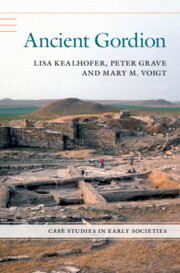Book contents
- Ancient Gordion
- Case Studies in Early Societies
- Ancient Gordion
- Copyright page
- Contents
- Acknowledgments
- Abbreviations
- 1 Introduction
- 2 Inventing Identity
- 3 Contextualizing the Ceramic Assemblage
- 4 Identifying Gordion’s Groups
- 5 The Late Bronze Age Community at Gordion
- 6 Reconstituting Community in the Early Iron Age
- 7 New Identities, New Communities
- 8 Enacting Power
- 9 Identities in Flux
- 10 Conclusion
- Appendix Eski Çağ’da Gordion:
- References
- Index
6 - Reconstituting Community in the Early Iron Age
The Early Iron Age YHSS 7 1150–900 BCE
Published online by Cambridge University Press: 23 September 2022
- Ancient Gordion
- Case Studies in Early Societies
- Ancient Gordion
- Copyright page
- Contents
- Acknowledgments
- Abbreviations
- 1 Introduction
- 2 Inventing Identity
- 3 Contextualizing the Ceramic Assemblage
- 4 Identifying Gordion’s Groups
- 5 The Late Bronze Age Community at Gordion
- 6 Reconstituting Community in the Early Iron Age
- 7 New Identities, New Communities
- 8 Enacting Power
- 9 Identities in Flux
- 10 Conclusion
- Appendix Eski Çağ’da Gordion:
- References
- Index
Summary
The early twelfth century BCE collapse of the Hittite Empire transformed cultural landscapes across Anatolia (Sams 2011a). These changes have variously been interpreted as the disruptive result of incoming groups, drought, local responses to a volatile political environment, either by themselves or in combination (Genz 2011; Kaniewski et al. 2015; Voigt 2011). In some regions, sites were abandoned or destroyed, while in others community organization was substantially altered. Gordion was occupied continuously through this transition, but the Early Iron Age (EIA YHSS 7) community’s material culture and social organization is marked by profound changes across a variety of spheres (i.e. ceramics, foodways, and house and storage structures).
- Type
- Chapter
- Information
- Ancient Gordion , pp. 136 - 170Publisher: Cambridge University PressPrint publication year: 2022

